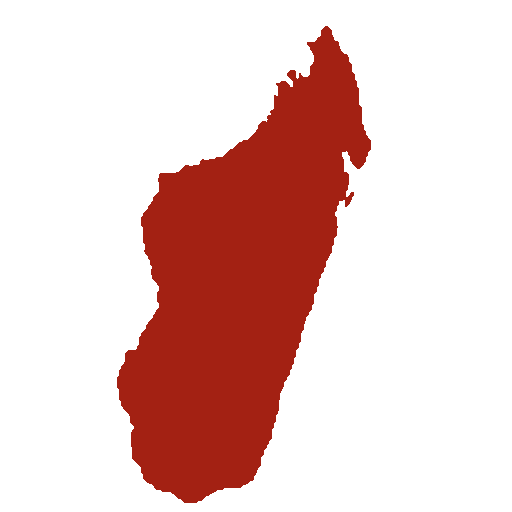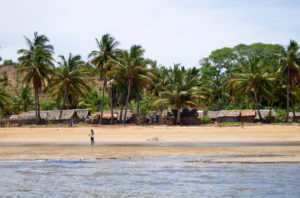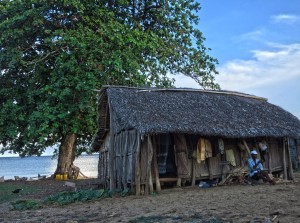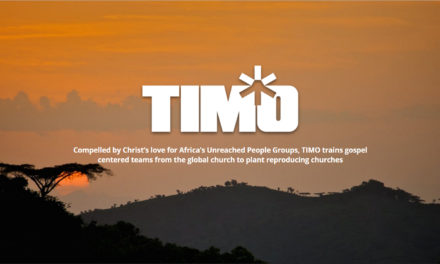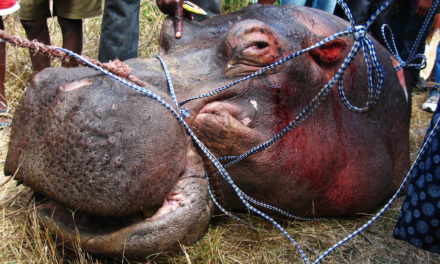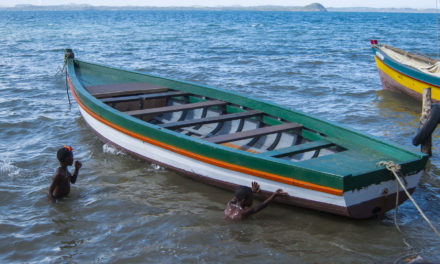W e’d been looking forward to this trip for months, with both hope and fear. We couldn’t wait to see the place where we’ll live for the next few years and meet the Antakarana people to whom God is calling us. We had a lot of thoughts and ideas about what we’d find there, but almost nothing to base them on. We were going to the unknown place. And our boat was speeding over the ocean towards it: the little remote island of Nosy Mitsio.
As we got closer, we saw a couple forlorn grass huts poking through the trees. One woman came out to the beach alone to see who we were and what we wanted. After meeting us, she ran back to get another man and helped us unload our boat. We had arrived!
W e only had a few days to spend there on Nosy Mitsio, but in that short time we learned a lot. For starters, the island may look really small and thin on a map, but when in person you can see that the island stretches and stretches almost as far as the eye can see. I guess when I think of a small island, I think of a small grove of trees surrounded by beaches, and I think of a hill in the middle where you can stand and see every surrounding shore. But Nosy Mitsio would probably take 2 or 3 days to walk around, at a fast all-day pace. And though inhabited by 2000 or more people, there is still plenty of open space with nobody and no trace of settlement to be seen. Although a tropical island, its climate and vegetation seemed to differ from other nearby islands – Nosy Mitsio is fairly dry with plant life more like the arid southwest of Madagascar than the tropical northwest where the island is located.
We spent most of our time travelling from village to village, meeting people, discussing our plans to move there next year and to bring a team of learners after that. We visited every village in the northern part of Nosy Mitsio and the two largest villages in the central and southern region. The villages of Nosy Mitsio are often much smaller than what we’ve seen in central and eastern Madagascar. They’re really just small clusters of family units, built around an older father or several siblings, with an average of 5 to 20 huts in each village. We met and spoke with the leaders of each family village, explained ourselves, asked different questions about local life, and if they’d be willing to have us or one of our team members live among them.
We were thankful to discover that their northwestern Antakarana dialect actually shares many similarities with the Betsimisaraka dialect that we’ve been learning here on the east coast of Madagascar. Though we definitely didn’t understand everything that was said (another Malagasy lady helped translate), it’s nice to know that we’ve got a good start.

One of the outrigger canoes used for fishing on Nosy Mitsio. The scene is looking onto another very small island in the bay of Nosy Mitsio.
Like the rest of Madagascar, the people of Nosy Mitsio grow rice. But on their little island with few constant waterways and only intermittent rainfall, they rely even more heavily on the harvest from the sea. Everywhere we went large fish were hanging on poles, drying in the sun. Most of the young men take their little outrigger canoes to the nearby coral reefs and go free diving with no breathing equipment at depths of 60 to 100 feet! Unfortunately, many of those young men stay down so long and come back up so quickly, that they often suffer from decompression sickness. Not entirely sure what, if anything, we had to offer them, many of the villagers asked for medicine to treat their diving symptoms. One of the men on our survey team said there’s very little, if anything, that can be done to treat it, but that long-term effects are serious. Making a living in Madagascar has never been very easy, and Nosy Mitsio is no exception.
Everywhere we went the people were very happy to welcome us and also agreed to host members of our team. They said that “vazaha” (white foreigners) are their friends because we helped them to chase away the Merina (Malagasy people in the central highlands after their big war almost 200 years ago. That conflict with the Merina, though long past, is central to the Antakarana identity. They’re a people, like most Malagasy, still living in the past.
A s we went from village to village and surveyed the island of Nosy Mitsio, we were always accompanied by “the King.” When we think of kings, we think of palaces and wealth, fine clothes and great power. Even when considering African kings, we think at least of powerful strong men with many warriors and many wives. But in Madagascar, and I think probably often throughout history, it’s usually not like that.
The King of Nosy Mitsio is a short unassuming man, probably in his 50s, wearing old shorts and tattered shirts every day, sometimes going barefoot, sometimes with sandals. He’s friendly and helpful, and was eager to see what we might have to offer, but not especially assertive himself nor strong of voice. He lived in one of the small thatched huts that we first saw when we arrived at Nosy Mitsio, along with his current wife and his five youngest children. They had two other small huts, one for food storage, and one for guests. And they had one dilapidated ramshackle house/hut, with a cement foundation still visible and a few pieces left of the tin roof, but most of it long since gone and blown away. There was trash strewn about the yard. This was the smallest “village” and there’s no one else living anywhere nearby.
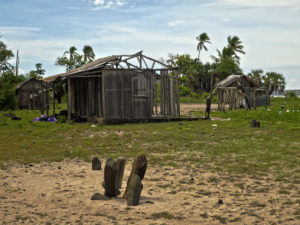
The central sacred stones next to the King’s “inheritance” (the run-down house) with the King’s other huts in the background. The flat stone altar/throne is still a little out of the picture in the front.
The King has many names, some are honorifics, some are titles in relation to other family members, and one was also the name of his grandfather, the last king before him. What made him the King is that he was born on the same day his grandfather died. As King, he’s obligated to live where he is, alone, as the guardian of the “standing stones” or “planted stones”. The broken-down hut is right next to a big square area with many stones arranged throughout, some in clusters, some as markers of the area, and a few propping up a giant stone slab. All of these stones were brought and arranged there back almost 200 years ago when the Antakarana first escaped the Merina and arrived safely on the island of Nosy Mitsio. They’re the stones of their “vow”.
On that giant stone slab, either the King sits (possibly the King of Nosy Mitsio or the greater Antakarana King of the mainland) or cows are sacrificed, or maybe both. We never understood clearly on that point. But the dilapidated house is the “inheritance” of the greater Antakarana King of mainland Madagascar. Every five years, a large gathering of Antakarana arrives at the site of the sacred stones for an elaborate pole or flag raising ceremony, and the greater Antakarana king from mainland Madagascar is supposed to stay in the house that’s his inheritance. As it currently stands, that run-down house is a shame to the King of Nosy Mitsio and he’s trying to find help or funds for rebuilding it, but without success so far.
So here we come and wind up in the middle of all of this. No matter how large or how small the political structure, it has its history, its intrigues, and its factions. We only scratched the surface of this one, but already we have an idea of its depth, and already we found ourselves becoming involved.
P art of our goal during this survey trip was to figure out where we should live, how our house should be built, where the materials come from, etc. As we went from one village to another and asked those questions, everything pointed back to the King. We met with the “President of the fokontany”, the official politically-recognized head of the land of Nosy Mitsio. Contrasted with the King, this man had much more wealth, was better-spoken, and quite assertive. Yet he said that despite any authority he might have, the King was the one with the real authority. Anything we wanted to do had to begin with him.
At the largest village of Nosy Mitsio, their sort of “port” (though there was nothing constructed to that effect), we met with the man in charge there. This old man was actually the older brother of the greater Antakarana King from mainland Madagascar. He was, to some extent, the uncle of the King of Nosy Mitsio. He was also the leader of the single Islamic mosque on Nosy Mitsio (though to what extent he understands or practices orthodox Islam has yet to be seen; he didn’t even know the word “Imam”). But again, he had more wealth and more presence. The King of Nosy Mitsio was with us as we visited him, barefoot and squatting low, as the old man sat high and told us his story, always referring back to the King of Nosy Mitsio. At one point he said, “though I am the father, the son has all the authority.” He told us that if we wanted to do anything on Nosy Mitsio, if there was anything we were there to learn, it had to begin with the King of Nosy Mitsio, it had to take place there next to the sacred stones.
There was very little of anything that we knew about the Antakarana people or Nosy Mitsio before we arrived. Nonetheless, Lora and I had hoped and expected to spend the next few years of our lives living in a normal thriving community surrounded by people and families doing the normal things that they do, letting us learn from them and build relationships with them as we lived among them. But as we returned from visiting all the villages and hearing what they had to tell us, we went back with the King to his small and lonely area, his representation of the whole, the heart of the Antakarana people. We looked around for a while and he showed us a plot of land, just a little ways back from his own hut, where he’d be glad to have us build our home and live among them.
S o that’s where we’ll be for the next few years: living next to the sacred stones, together with the King of Nosy Mitsio and his small family. We’ll be living among that small group of people, a bit separated from the rest of the Antakarana on the island there. And we’ll be living on Nosy Mitsio, separated by 35km of ocean from the rest of mainland Madagascar, from our closest contact with the world. As the Antakarana people fled from that which troubled them, this is where they ended up, far from anyone else and disconnected from the world. Soon we’ll be there with them.
I have no doubt that in that bit of isolation and loneliness, we might start to understand a little of the separation that the Antakarana feel exists between them and their Creator. For now they use intermediaries, they make sacrifices and follow vows to their ancestors in the hopes that their ancestors will be able to give safety and blessings to their lives, since their ancestors are the only ones who might have contact with the Creator God, the ultimate source of power and authority. And maybe in our understanding we can speak to them, in their own language and dialect, and in the thoughts that make sense to them. And maybe in our understanding of them they’ll be willing to listen to us. And maybe we can share with them and maybe they can believe and accept: that the division between God and them is no more, that he himself became our intermediary, that one sacrifice was given once and for all, that new and abundant life is ours at last. And maybe that lonely place on that lonely island will become a place of reconciliation, a place where the Antakarana will find what they’ve been missing all along.
